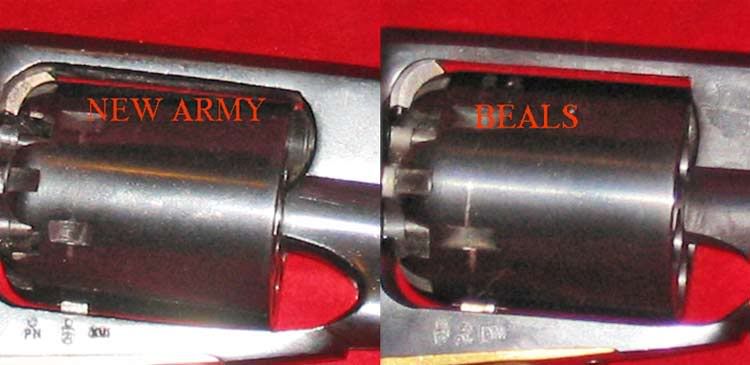Carrying on with the Remington, the first pistols made were called the Remington Beals Pocket Revolver (named after it's inventor and patent holder).
This was a somewhat odd looking single action, .31 caliber, 5 shot pistol which used a full frame with a top strap. It was first made in 1857 and went thru three fairly extensive revisions before it went out of production in 1860 after a production of over 7,500.
This Pocket Revolver is not the later "New Model Pocket Revolver" being reproduced by the Italian companies although its third model is somewhat similar to it.
In 1860, Remington also produced a double action .31 caliber, 5 shot pocket pistol. Called the Remington-Rider Pocket Revolver it was named after its designer Joseph Rider of Ohio.
This little gun's most notable features was a full trigger guard, double action trigger and extremely short grip.
It was produced from 1860 thru 1873 with about 20,000 being made. Most of these Rider pistols were later reworked into metallic cartridge guns.
The gun we call the "1858 Remington" was never called a 1858 Remington. The "1858" refers to the date of Beals patent on the design.
It started life as the Remington-Beals Navy Model Revolver, a .36 caliber, 6 shot full framed gun.
Enlarging the frame, cylinder and barrel a bit allowed the creation of the Remington-Beals Army Model Revolver in .44 caliber.
These guns went into production in 1861.
Remington made a revision to the loading lever to allow easy removal of the cylinder pin to facilitate rapid replacement of the cylinder to reload the gun and offered it to the Army calling it the Remington-Beals 1861 Army Revolver.
The Army wasn't impressed with several things about this new model. The biggest complaint was the cylinder pin followed by the fact that the gun tended to bind up and not rotate the cylinder after a few shots had been fired.
The cylinder pin problem was due to the method of retaining it. The top of the loading lever cleared the barrel by about 1/4 of an inch which allowed the pin to be retracted without dropping the loading lever. This increased the speed for changing the cylinder to reload the gun but it also allowed the pin to move forward on its own without the shooters knowledge.
When this happened, the cylinder would bind up or worse, even fall out of the gun unexpectedly.
The existing early 1861 guns were reworked to add a screw just ahead of the end of the cylinder pin in the top of the loading lever. This screws head blocked the movement of the pin.
The loading lever was redesigned to remove the gap with the barrel just forward of the end of the cylinder pin to prevent its movement. By dropping the loading lever the pin could be easily removed and this lever was used on all of the subsequent Remington Beals.
Although this helped to make the gun less objectionable to the Army it still had the problem of locking up due to fouling.
To solve this problem, Remington redesigned the frame to move it away from the front face of the cylinder and expose the barrels threads.
This allowed the exposed threads to remove the fouling on the front of the cylinder by scraping it clean.
This new frame coupled with the improved cylinder pin retention was called the Remington New Army Model and between 1863 and 1875 about 132,000 were produced.
It is this model that most of the Italian reproductions represent however, if you buy a older Remington reproduction it may have the older style frame and basically is a copy of the old Remington-Beals Army Model Revolver and, yes, it does tend to bind up fairly rapidly.
In the photo below, you can see the "old" frame on the right and the "New Model Army) with the exposed barrel threads on the left.
The little Remington New Model Pocket Revolver currently being sold is a faithful reproduction of a .31 caliber 5 shot spur trigger gun that Remington made in both brass framed and steel framed versions from 1863 thru 1873.
About 25,000 were produced.
zonie





